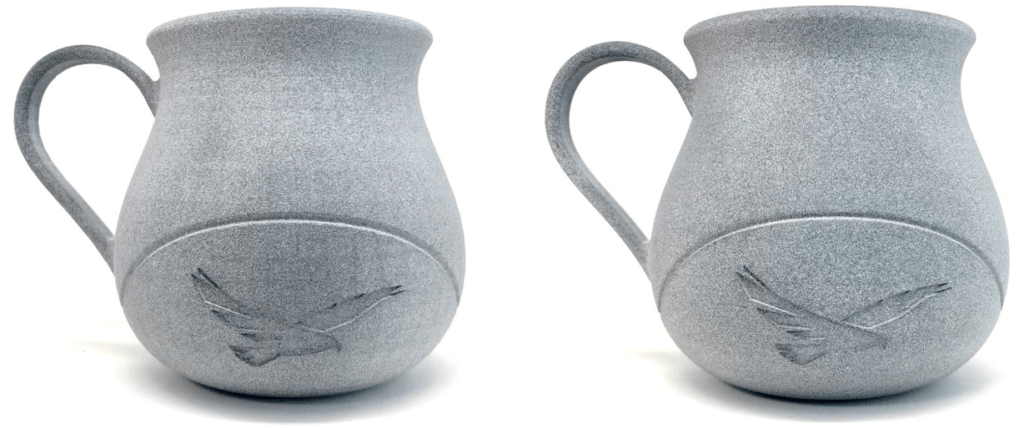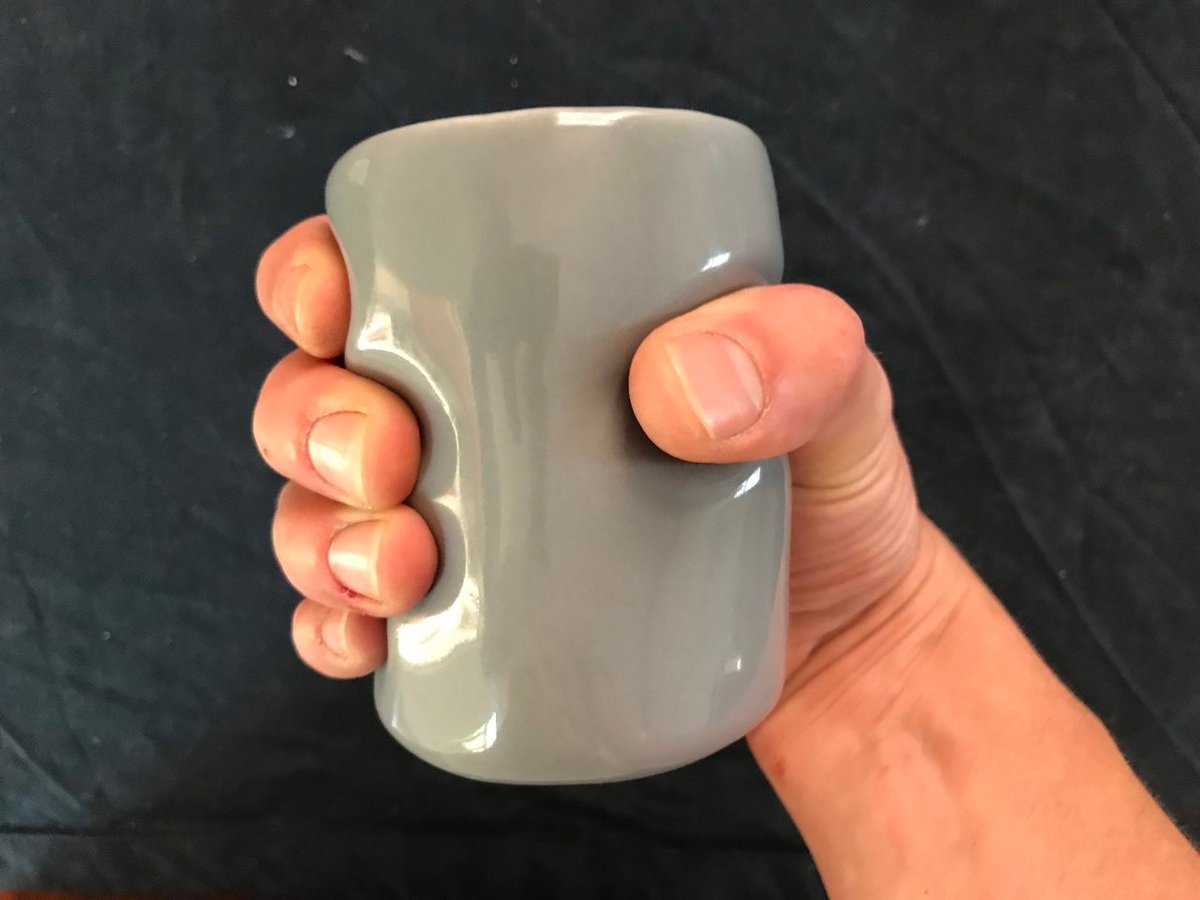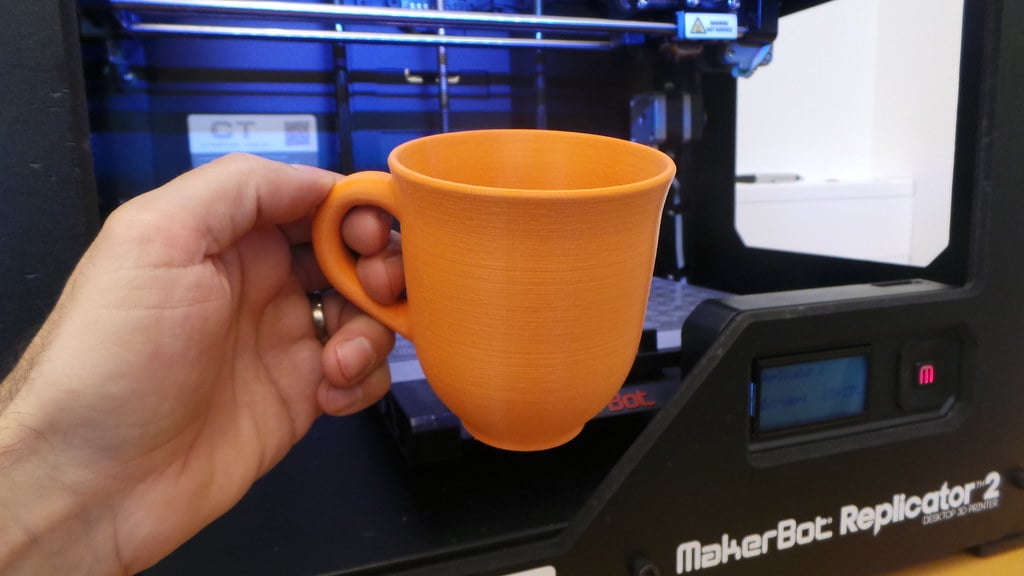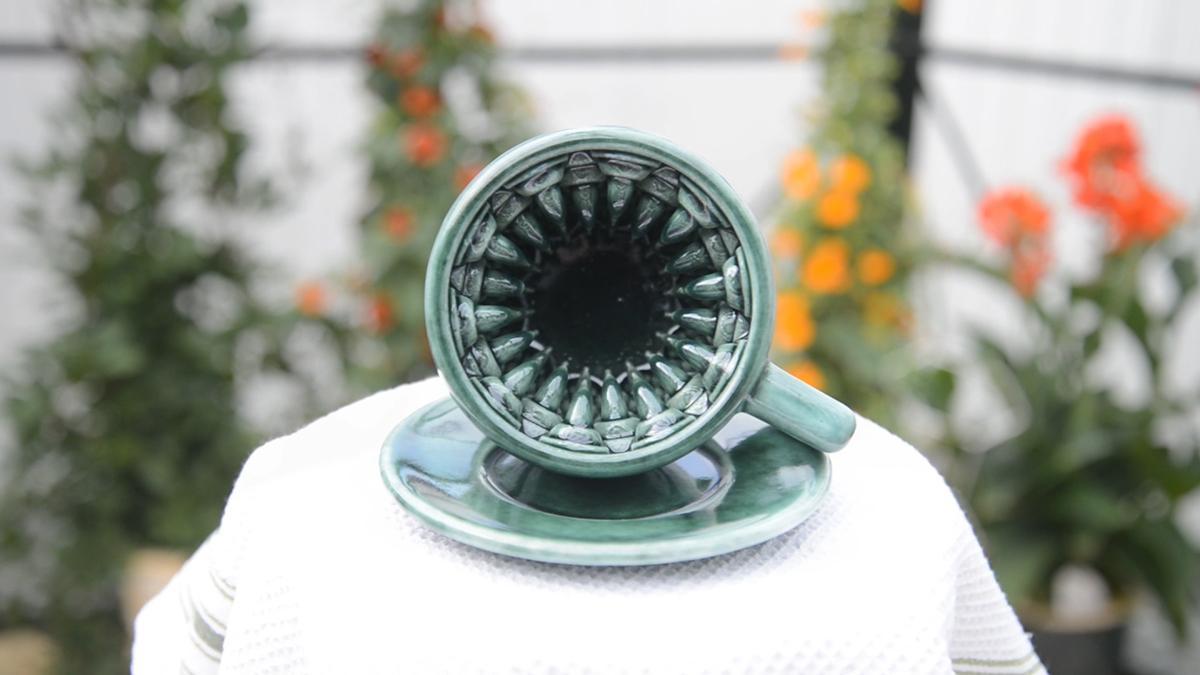Custom Containers

3D printing is useful for all sorts of things, including holding your morning beverage of choice. Using 3D printing to make a coffee mug is not only possible, it’s also useful for everyday purposes, and handy when you run out of gift ideas.
Before you start printing, however, there are a few important things to consider.
What to Consider
First and foremost, not all 3D printing filaments are safe to use in contact with food or drink. Many filaments are made from plastics and other polymers containing chemicals that are harmful to humans when ingested, and the 3D printing process of heating those filaments doesn’t sterilize them.
Next, a number of filaments are sensitive to heat or liquid, and will break down if exposed to large amounts of either.
Finally, the process of 3D printing often leaves tiny openings between the layers of the object. They’re too small for the human eye to see but the perfect size for microscopic bacteria to flourish, especially because these spaces are so hard to clean. Making sure 3D printed objects are 100% safe to eat or drink from often relies on special finishes that fill in these unseen spaces.
That may sound like a lot of potential pitfalls, but don’t be discouraged! With the tips we’ve collected below, the right filament, and lots of care, you can print all the coffee mugs you want without worrying about a thing.
If you become inspired to obtain your own personalized mug but don’t have the means to make it yourself, try Craftcloud by All3DP. Apart from professional quality printing, you’ll have a wide spectrum of materials to choose from. Just be sure to apply the appropriate post-processing steps to make the final product food-safe.
Choosing a Design

Designs for 3D printed coffee mugs are all over the internet, useful for both inspiration and printing straight from a free download.
Features
Before you start, make sure you know your own drinking preferences (or the ones of whoever will be receiving the mug). It may sound a little silly, but we often don’t pay attention to gestures we make every day – like drinking coffee – and that can lead to a finished project that just isn’t your cup of tea. Here’s what to note about mugs you already like:
- Size: Size is important for every 3D printing design, of course, but for a 3D printed coffee mug, it gets personal. Whether you drink an espresso that’s best sipped out of something smaller than your palm or you need something oversized to keep you caffeinated without going for a refill every ten minutes, you’ll likely find a design to suit your fancy. Just remember the capacity of the 3D printer you’ll be using, otherwise you might end up with only half of a cup.
- Handle (or lack thereof): The vast majority of mugs come with some sort of handle on one side – useful for drinking something while it’s still hot. You may want to measure the circumference of several coffee mugs in real life before choosing a design to get an idea of how big the handle will be once your 3D printing project is finished. And of course, if you don’t want a handle at all, there are designs that mimic takeout cups rather than standard mugs, so you can pretend like you’ve just come from your favorite cafe.
- Rim: Do you like a slant or curve to your coffee mug’s top? It makes more difference than you think, with some designs boasting a perfect angle to cool liquid to just the right temperature before it reaches your lips. If you always seem to scorch your tongue, these may be worth looking into.
- Shape: Yes, there is totally more than one shape of coffee mug. This is especially important to realize if you’re eyeing novelty designs, like those based on something recognizable from pop culture. Novelty mugs may be in the shape of an object from a video game, for instance, or the head of a cartoon character – in other words, more intricate than a plain coffee mug’s basic cylinder. If you think an unusual shape will interfere with your sipping, print a plain design with a picture of your fandom on it instead.
Sources
Once you’ve figured out what you need in a design, it’s time to find something that catches your eye. Open 3D model repositories often have hundreds if not thousands of plans available, so narrowing your options even a little before you look will make the experience a lot more fruitful.
- Thingiverse: Thingiverse is the great democratizer of online repositories. It’s open for all 3D designers to post their free designs. Their parent company, MakerBot, boasts that Thingiverse has the largest 3D printing community on the internet, and hundreds of results come up in a search for “coffee mug”.
- Cults: A site similar to Thingiverse, Cults has huge collections of 3D printable designs. The difference between Cults and Thingiverse is mainly that Cults also offers paid models, allowing designers to be compensated for creating higher quality designs.
- MyMiniFactory: MyMiniFactory is a third model repository, sharing features with both Cults and Thingiverse. The distinction is simply that on MyMiniFactory, the vast majority if not all designs, are proven to be printable on either an FDM or resin 3D printer, meaning you can be more secure in the feasibility of manufacturing your model of choice.
- All3DP: We have ideas for you, too! Check out our article on curated cup designs to see if anything catches your fancy.
Best Filaments

As we’ve mentioned, it’s of the utmost importance to know what 3D printing materials are safe (and useful) for printing a coffee mug. Here are the details on what you need to make sure you can use it for its intended purpose without having to worry.
- PETG: PET and PETG are widely known as some of the very few food-safe 3D printing filaments. These materials are relatively easy to print, but keep in mind that depending on the manufacturer, they can start to get soft at temperatures just a little over 100 °C, so we don’t advise using cups printed in PETG for recently boiled water.
- Resins: One way to get past some of the limitations of 3D printing your coffee mug is to use resin-based printing instead of FDM. Resin printing gives you more ability to work in detail with ceramics and other materials that don’t perform as well when used as filaments. Make sure to use food-safe resins, and cure them properly before use.
- Ceramic: It’s easy to remember that ceramic is a safe, effective material for your 3D printed coffee mugs because it’s likely what most of your cups are already made with. This is because ceramic’s structure makes it strong, heat-absorbing, and nonporous; just what you need for your cup(s) of joe. Ceramic is, however, hard to come by as a filament or resin, and printers equipped with paste extruders won’t be capable of quite the same amount of detail as printing with other materials.
- Metal: If you’re lucky enough to have access to a metal 3D printer, or have enough money to order a mug printed in metal, aluminum, tin, and stainless steel are all food-safe materials that are suitable for a 3D printed mug. An alternative option is to use a casting technique, using a part printed in another material like wax. Note that you will need to polish the print to remove any crevices in which bacteria may want to hide.
If you don’t have access to any of these materials, don’t worry. In the next section, we have some ways to get around this. The main thing is to make sure that it can resist higher temperatures, especially if you’ll be using it for hot drinks.
Finishing

The best way to make sure your 3D printed coffee mug is safe for drinking and easy to clean is to add a finish to your object. For the most part, this is basically adding a food-safe finish to the print, an example being adding a food-safe glaze to a ceramic mug. You’ll also want to smooth porous surfaces to create less space for bacteria to multiply.
Below are a few finishing options that work well for a 3D printed coffee mug.
Polyurethane Finish
Dip your 3D printed coffee mug into one of these polyurethane resins, and the liquid plastic will coat the object in a thin layer that cures into a protective shell. Most polyurethanes are clear, letting your original design and colors shine through, and most polyurethanes are considered to be food-safe once fully cured.
Using polyurethane coatings is an excellent way to make 3D printed mugs food-safe, even if the original material isn’t itself. With the raging debate around whether any 3D printed object is food-safe or not, regardless of material, it’s always good to be extra careful, which is why we recommend using an additional coating.
Make sure your choice of polyurethane has low viscosity (thin and runny instead of thick) so it will cover all of the little cracks and details of your design. Also, always read the manufacturer’s label for any warnings that may indicate it’s not food-safe.
Resin Curing & Post-Processing
If you choose to use resin for your 3D printed coffee mug, it will go through a curing stage where UV light hardens the object. This is not a complete finishing process to make the mug food-safe on its own, but it’s what keeps the print smooth so bacteria can’t get in. To make your SLA mug truly coffee-safe, use an appropriate finish, such as polyurethane (or glaze in the case of ceramic resins) as a post-processing step.
PLA Smoothing
PLA is a biodegradable plastic that’s also technically food-safe. However, when printed, it still exhibits the porous properties that make 3D prints so vulnerable to invisible microbes. To combat this, you can try a process called PLA smoothing. Basically, that’s a collective name for a number of processes that do exactly what the name says: smooth the layer lines off your 3D printed PLA objects.
Of course, PLA is also a poor choice if you want a mug for hot liquids. That’s because it starts to be affected by heat after about 60 °C.
Note that all 3D printing finishes are prone to deterioration if subjected to harsh usage or washing conditions. We’ll go into detail about how to take care of your 3D printed coffee mug in the following section.
Maintaining

When regularly using a 3D printed coffee mug, you have to be careful about how you clean and care for it. For instance, you may not want to put it in an automatic dishwasher. In that environment, even filaments that can withstand hot liquids can get bumped around enough to become more brittle and prone to breakages. Plus, the sustained intensity of such cleaning can chip away at finishes meant for filament protection, thus rendering them less useful over time.
Here are a few ways to keep your 3D printed coffee mug as good as the day it came off the print bed.
- Hand washing: PLA and nylon are both weakened by the agitation of dishwashers. Instead, use warm water and antibacterial soap to hand wash them in your sink. Resin prints are also more brittle, meaning that it’s better to wash them by hand, as well.
- Dishwasher safety: Ceramic and certain metals are dishwasher safe, including aluminum, tin, and stainless steel. Be careful when arranging them on the racks, and make sure to run a wash with just your 3D printed coffee mug(s) on the top rack to minimize the chances of excess agitation and wear. If you have a printed mug with a polyurethane (or similar) finish, read the finish’s safety warnings to see if it’s dishwasher safe, at all, and if it is, what layer thickness is needed to endure that process.
- Storage: Always keep your 3D printed objects in cool, dry areas, including your coffee mugs. Put them in cabinets away from the stove, and avoid using open shelving to keep external kitchen contamination at a minimum. Store your 3D printed coffee mugs upside down to avoid dust, and make sure you rotate your usage with your other favorite morning beverage cups to extend its life cycle.
3D printing your own coffee mug is a great chance for personal expression, practicality, or gift-giving. Just remember to use extra caution and research during each step so your project comes out safe and ready to use.
Lead image source: AN-Cadsolutions via Twitter
License: The text of "How to 3D Print a Coffee Mug: Tips & Tricks" by All3DP is licensed under a Creative Commons Attribution 4.0 International License.
